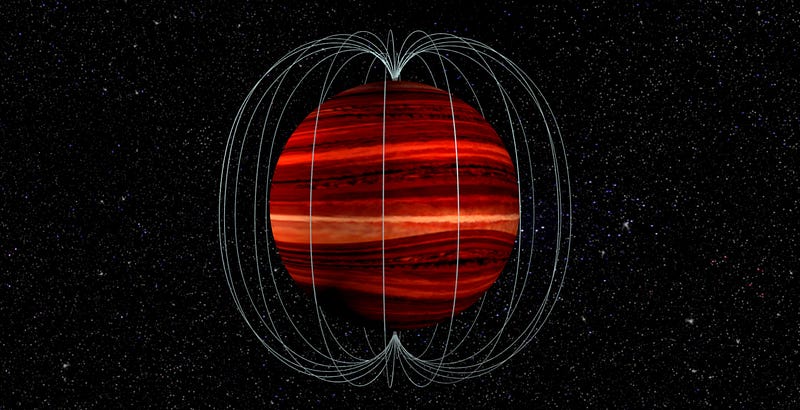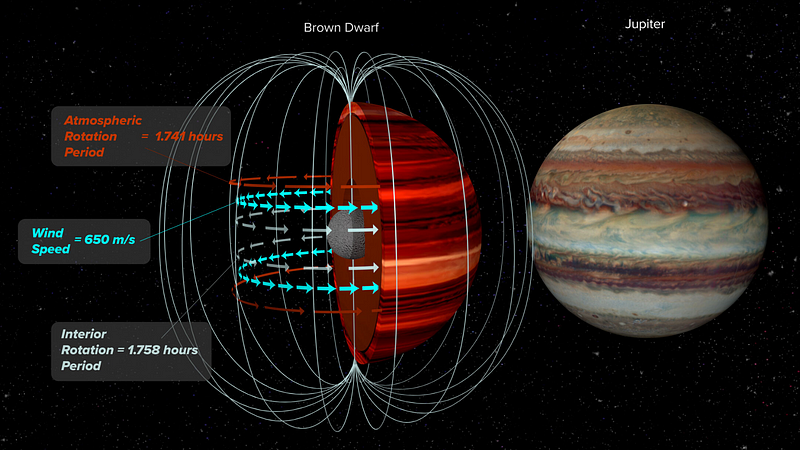Exploring Wind Speeds of Brown Dwarfs: A Cosmic Breakthrough
Written on
Understanding Wind Speeds in Brown Dwarfs
Astronomers have successfully measured wind speeds on brown dwarfs—often categorized as ‘failed stars’—for the very first time. This groundbreaking achievement is crucial for both comprehending these unique celestial bodies and furthering research into exoplanets. Utilizing a combination of the Very Large Array (VLA), which comprises 28 radio telescopes situated in New Mexico, and NASA's Spitzer Space Telescope, researchers have documented their findings on the brown dwarf 2MASS J0475385+212434 (2M1047), located 34 light-years from Earth. This discovery not only sheds light on the atmospheres of brown dwarfs but also offers insights into gas giant planets and the study of exoplanets.

The research team, led by Katelyn Allers from Bucknell University, applied methods previously used to measure wind speeds on the solar system's giant planets, such as Jupiter and Saturn. Their findings, published in the journal Science, reveal that the wind speeds on 2M1047 are significantly higher than those found on Jupiter and other gas giants.
Brown Dwarfs: The Bridge Between Stars and Planets
Brown dwarfs exemplify the concept of ‘failed stars,’ possessing a radius comparable to that of Jupiter while having a mass approximately 40 times greater. Despite this substantial mass, they lack the density required to initiate the thermonuclear fusion processes that characterize stars. According to Dr. Beth Biller from the University of Edinburgh, a co-author of the study, “A brown dwarf is an object that is too massive to be classified as a planet, yet insufficiently massive to ignite star-like hydrogen fusion.”
Biller elaborates that brown dwarfs share many traits with gas giant planets, including similar physical dimensions. Interestingly, cooler brown dwarfs exhibit cloud and atmospheric characteristics akin to those of gas giants. “These objects are considerably hotter than the planets in our solar system—cloud top temperatures may resemble that of a candle flame—but still fall short of stellar temperatures,” Biller explains. “Consequently, clouds can condense within their atmospheres; however, these clouds are not comprised of water vapor.”
The researchers anticipate that the similarities between Jupiter and brown dwarfs like 2M1047 extend beyond their surfaces and atmospheres. This correlation led the team to conclude that the same methodologies used to measure wind speeds on Jupiter could effectively apply to brown dwarfs.
Magnetic Fields and Wind Speed Measurements
In studying Jupiter, astronomers have observed discrepancies between rotational period measurements obtained through radio and visible/infrared observations. Allers points out that this difference arises because radio emissions result from electrons interacting with Jupiter’s magnetic field deep within its core, while infrared emissions emanate from the upper atmosphere. As a consequence of atmospheric winds, the atmosphere of Jupiter rotates at a faster rate than its interior.
Calculating wind speeds thus involves subtracting the interior velocity, as determined by radio observations, from the atmospheric velocity measured through infrared observations.

“If you analyze Jupiter’s rotation using its radio emissions, you’ll find a period of approximately 9 hours, 55 minutes, and 30 seconds; however, using optical or near-infrared methods yields a slightly different period of 9 hours, 50 minutes, and 30 seconds,” Biller notes. “The five-minute discrepancy corresponds to a velocity difference of around 100 m/s, which is reflective of the equatorial winds on Jupiter.”
The team expects similar mechanisms to influence 2M1047, prompting them to conduct complementary observations with the VLT and Spitzer telescopes—utilizing radio and infrared technologies respectively—to determine the brown dwarf’s wind speeds.
Their observations of 2M1047 in 2017 and 2018 revealed a consistent variation in infrared brightness, likely due to a stable feature within its upper atmosphere. Subsequently, they took radio measurements of the interior in 2018.
“We found a wind speed of about 1425 miles per hour—substantially faster than Jupiter’s winds, which measure around 230 mph,” Biller reveals. “This marks the first recorded wind speed for any cool extrasolar object.”
The findings align with theoretical predictions regarding atmospheric conditions on brown dwarfs. Moving forward, the researchers aim to apply their innovative techniques to other brown dwarfs and potentially exoplanets. However, adjustments may be needed since exoplanets typically exhibit weaker magnetic fields than brown dwarfs, necessitating lower-frequency measurements.
Biller suggests that this research may also provide an indirect means of studying exoplanets: “Because brown dwarfs often serve as good analogues for exoplanets, we can investigate their atmospheric properties as proxies for atmospheres that are more challenging to study directly, such as gas giants obscured by the brightness of their parent stars.”
The team has currently applied this method to one brown dwarf but is enthusiastic about the possibilities of measuring wind speeds on numerous additional celestial objects in the future!
Watch the video "We Measured Wind Speed of a Brown Dwarf For the First Time Ever" to learn more about this groundbreaking discovery.
Check out the video "Brown dwarf wind speed measured for first time" for further insights into this exciting research.
Source:
Allers, K.N., Vos, K.M., Biller, B.A., Williams, P.K.G. "A measurement of the wind speed on a brown dwarf." Science, (2020). http://dx.doi.org/10.1126/science.aaz2856
Rob is a freelance science journalist from the UK, specializing in physics, astronomy, cosmology, quantum mechanics, and obscure comic books.
Did you enjoy this article? Join us on The Cosmic Companion Network for our podcast, weekly video series, informative newsletter, news briefings on Amazon Alexa, and more!